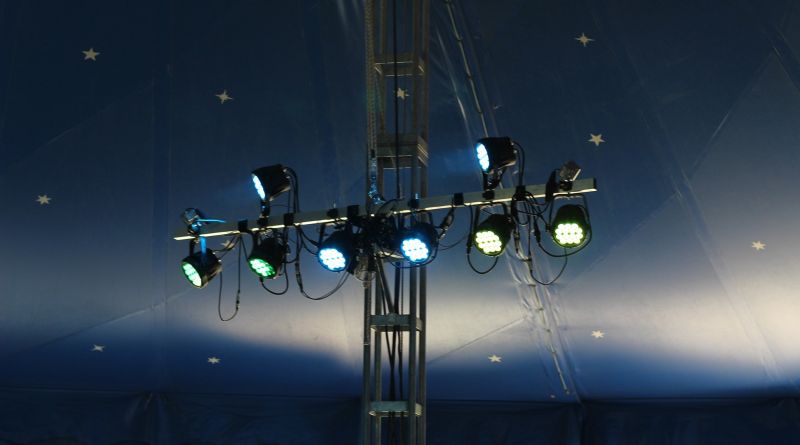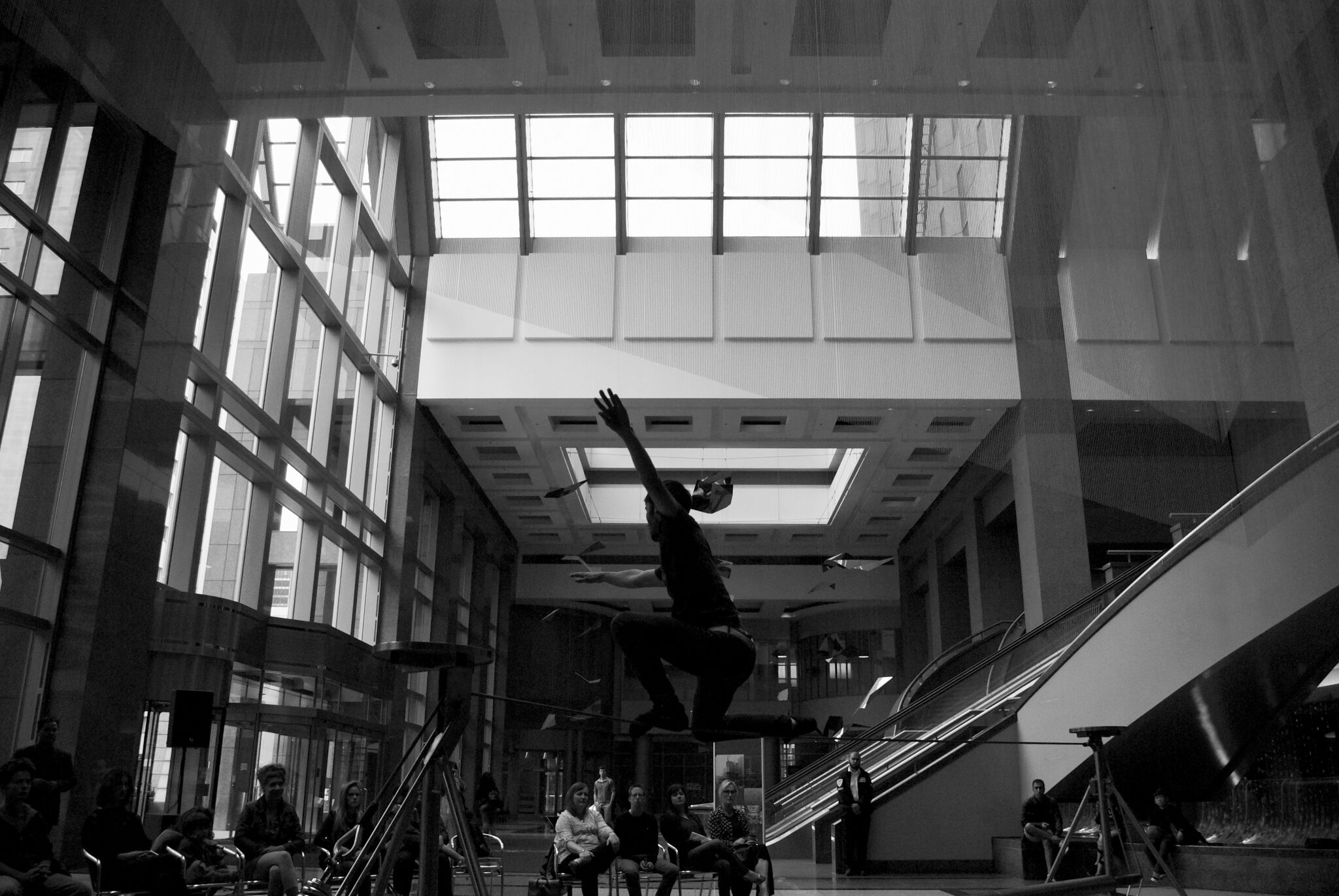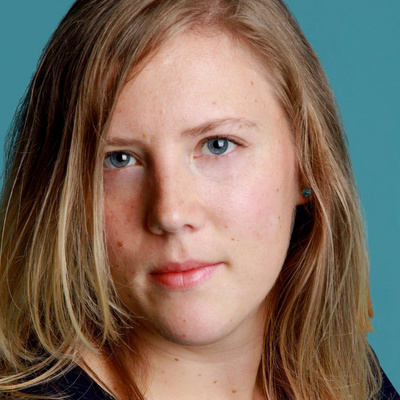Field Guide To Circus Dramaturgy

Setting the Stage
In late August of 2012, I drove across the border at the Thousand Islands Bridge on Hill Island between Ontario and New York State to start my adventure as a Master’s student at the University of Massachusetts Amherst. I had completed all of my paperwork, and filled out all of the forms. The last step of the process was simply getting my F-1 student visa, which for Canadians happens at the border. When my name was finally called and I went up to the counter, the agent asked. “What are you taking in school?” “Dramaturgy,” I responded. “What the hell is that?” My face flushed as I waiting for my brain to kick in and provide an answer to what seems like a simple question. “Uh, theatre studies,” I finally spat out. Good enough for him. But not for me. I had no idea what I was getting myself into.
Over the years, I learned a great deal about what dramaturgy is. And yet, a clear definition of what it is remains elusive, almost intangible. Marianne Van Kerkhoven explains that “dramaturgy involves everything, is to be found in everything, and is hard to pin down.”[1]
My favourite description of what dramaturgy comes from Dr. David Williams, who says that dramaturgy is “about the rhythmed assemblage of settings, people, texts and things. It is concerned with the composing and orchestration of events for and in particular contexts, tracking the implications of and connective relations between materials, and shaping them to find effective forms.”[2] To me, dramaturgy is about seeing, listening, questioning, and communicating meaning and intention. Our job as dramaturgs changes and adapts to each different production, as each creation process demands something different of us.
But what does dramaturgy look like? Can these dramaturgical skills be applied to circus? This article will identify the key tools and practices of dramaturgy for theatre and look at the ways they can be modified or adapted to be employed in the creation of circus arts. I will also address the many ways that dramaturgy or a dramaturg can be brought into the creation process or rehearsal room. For further resources, visit my Dramaturgy Resource website.
Dramaturgy in the Production Process

There are two main components to production dramaturgy: what happens inside the production process (the play, production concepts, rehearsals) and what happens outside or after that process (while the production is on). In ‘theatre, we most often work in a top-down model of a director who has a vision for a production of a set script. In this model, the dramaturg will do a lot of research and analysis of the text. We will look at historical and contextual research about the setting of a play, production history, and we will do a plot bead (visual representation of the action) and scene breakdown. We will also do critical research looking at what has been written about a play, including academic articles, reviews, and position papers. And finally, we will do creative research, which means finding things that speak to the imagery and themes in the play, like songs, poems, or images.
Although circus is nuanced and comes in many forms, not all audiences have the tools to understand the codes and conventions of circus performances.
We gather all of this material together before the production process begins so that we can assist the designers in making choices by answering their questions (for example, what colour of fabric were peasants allowed to wear in the 17th century), or helping the director clarify what narrative they are telling, or aiding actors to understand the text and the world of the play through actor packets. Actor packets are one of my favourite things to create for productions. They differ for each production and sometimes for each cast member depending on what they want and how they like to work. I have created YouTube videos of images, a detailed breakdown of exactly how much time it would take for someone to travel by horse from city to city in the 19th century, and even created a historical scavenger hunt! As a dramaturg, I am always learning new things through each process.
Many of these techniques can be applied to circus dramaturgy as well to help creators and performers better understand the world they are creating or delving into. While scene breakdowns and script analysis may seem irrelevant to circus performances, the questions that we ask during the production process– and the assistance and information we can provide– are very interdisciplinary.

Dramaturgs can also be a part of the devised or collective theatre process, a creation process that is often used in circus. In this way of working, a production starts with an impulse, an idea, a theme. A dramaturg supports this creation process by bringing in materials that could inspire the artists in their work. For example, if a production were to be based in 19th century France, a dramaturg could bring in Impressionist paintings by Manet or Degas. The way these artists depict figures could inform the lines of movement of artists or the choices of which disciplines to include in their piece. From there, a dramaturg could bring in music that has the same feeling as these Impressionist paintings.
It is important to note that while I advocate for companies to use a dramaturg because of how valuable it is to have someone dedicated solely to this work in the space, it may not always be possible to employ a dramaturg. But, with the right tools and an understanding of dramaturgical impulses, artists can often do this work on their own. Another model that could be useful for circus is that a dramaturg can be brought in as a consultant to help clarify a story once an initial draft or performance has been developed. As an outside eye, the dramaturg is not focused on research or context, but purely on the narrative, the performance, and the experience of the show as the audience would see it.
While in a rehearsal, a dramaturg acts as the first audience member; he or she is trying to understand the production from the point of view of someone who knows nothing about the process. So we ask a lot of questions, not to judge the director’s choices, but rather to help them clarify the story they are telling. We may ask about their intention in a particular scene, or what a relationship is between two characters, or what the meaning is behind a particular movement.
The goal of the dramaturg is to provide an alternative perspective or to provoke the director to critically analyze a choice they have made so that either they confirm that their intention is coming across or it is not and perhaps a different route needs to be take

While working as the production dramaturg for Louis Patrick Leroux’s Hamlet on the Wire – a circus adaptation of Hamlet’s soliloquy on high wire — I focused on the relationship between text, sound, and visual image. One goal that we had was to look at what changed for the audience and the performer when the text caused the artists (François Bouvier) to move, rather than his movement being the instigation for the text. So, I looked at the meaning of Hamlet’s speech, line by line, breaking down what his intention was, what he was questioning, and whether or not he seemed to be (or felt he was) in charge on his own fate at that particular moment. In the rehearsal room, I would look at the lines of movement being developed for each phrase to see whether or not it elicited the same emotional or visceral response as Hamlet’s dialogue. Through this line of questioning with the director (Patrick), we were able to clarify the choices made in the performance, so that every element of the production worked together to convey the narrative that Patrick wanted to tell.
Dramaturgy and the Audience
This brings me to the second component of dramaturgy, which involves the audience. To me, this is the part of the dramaturgical process that often gets overlooked, but is equally or perhaps even more important. While in the rehearsal room, we are helping the creative team, whether it is one director or a group developing a piece collectively, to create an experience that tells the story or evokes the meaning that they are trying to get across in the most effective way possible for that particular production. I emphasize this because each production is different, even if it is starting with the same script, theme or idea, so the whole dramaturgical process has to be focused specifically on the vision of that particular production, whether it be a solo performance in a small, unconventional space, a large commercial production in a circus tent or permanent theatre space.
Once the production is up, the role of the dramaturg shifts and our job is to help the audience have the most enjoyable and fulfilling experience possible. This, like the actor packets, can take many forms. For the production I mentioned earlier that covered 75 years of history, I developed a program that included a dramaturgical note about the social structure in 18th century France, a timeline that ran across the bottom of the centrefold pages that had little markers of events in the play, and a visual representation of the relationship between characters in the play. For other productions, I have done lobby displays that featured the sketches for the costumes in the production with information about the history of clothing from those eras. I have also created websites full of information, teasers, quizzes, and feedback forms. The goal of each of these elements is to enrich the audience experience, engage them beyond the theatre space, and get them invested in the production.
The Right Tools
Communication with the audience, particularly to get them engaged with the performance is essential for a dramaturg working on any performance art, but particularly circus arts. There are a great number of preconceived ideas about what circus is that affect audience expectations when they enter into a performance space. For example, an audience member’s only reference point for circus may be from the fair in their hometown as a child (as was the case for me until two years ago). Although circus is nuanced and comes in many forms, not all audiences have the tools to understand the codes and conventions of circus performances. A dramaturg’s work has the potential to change this, to provide an audience member with some knowledge that would help them gain insight into the performance and the art form that they are experiencing. For example, a dramaturg could develop a website that features the different disciplines featured in a show and provide some history into each one. Or they could create a lobby display that centers on the collective experience of the performers on stage and their relationship to the success and failure of particular tricks or movements. Or perhaps they could create a multimedia gallery of material that inspired the production, giving audiences a better understanding of the creative process. Also, a dramaturg could film small segments of rehearsals and put together a series of teasers that are sent out (or available on a website) to ticket holders prior to the performance to get them interested in the show and also to help them understand the physical demands that are made on the performers on stage.
Depending on the size of the company, dramaturgs may work with marketing teams as well to develop these materials — or they may be the one-person marketing team themselves. For larger companies, it is valuable to make the dramaturgical materials available to all those involved in the production, including carpenters, the house crew, the marketing team and of course the artists as they all have the potential to affect the production and the audience experience. Through technology we have so many opportunities to reach out to audiences, and to draw them in, so that they are that much more giving to the performers when they enter the space. By giving audiences more tools and by helping them to develop a better understanding of circus arts, we can develop informed audiences that think about what they have seen beyond aesthetics and physical prowess — audiences that are more willing to see performances that challenge their assumptions about circus. And audiences that keep coming back for more.
[1] Cathy Turner and Synne K. Behrndt, Dramaturgy and Performance [New York: Palgrave Macmillan, 2008], 17. [2] David Williams, “Geographies of Requiredness: Notes on the Dramaturg in Collaborative Devising” , Contemporary Theatre Review Vol 20(2) [2010], 197-198.
Editor's Note: At StageLync, an international platform for the performing arts, we celebrate the diversity of our writers' backgrounds. We recognize and support their choice to use either American or British English in their articles, respecting their individual preferences and origins. This policy allows us to embrace a wide range of linguistic expressions, enriching our content and reflecting the global nature of our community.
🎧 Join us on the StageLync Podcast for inspiring stories from the world of performing arts! Tune in to hear from the creative minds who bring magic to life, both onstage and behind the scenes. 🎙️ 👉 Listen now!
